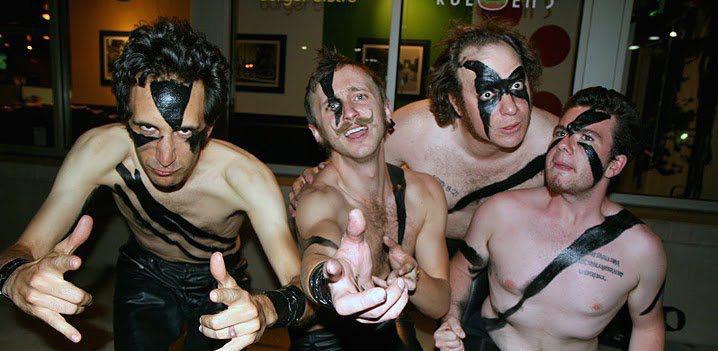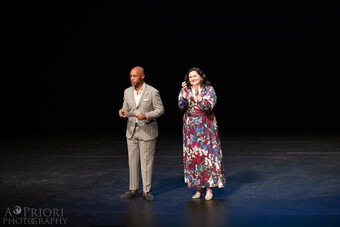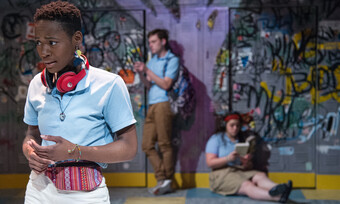Building Your Identity and Fan Base Like a Metal Band
This post is part of a series exploring what it's like for an artist to have an entrepreneurial mindset, and all of the different challenges that can come with it.
When I first started to explore bands like Iron Maiden and Metallica at age twelve, I was scared out of my mind. Was I embarking on the work of the devil? The cover art freaked me out, the lyrics were mysterious and dark, and the bands looked deathly serious in their photos. But I was hooked within a few months, a total convert. The speed, complexity, and technicality of the sounds actually made my mouth drop and say things under my breath like, “That’s fucking insane.”
I spent hours reading the cassette foldouts, studying the lyrics, the liner notes, who was thanked, the in-jokes that I would soon come to understand from talking with my friends and reading fanzines. I was terrible at drawing but I did my best to replicate the logos of the bands on the outside of my textbook. The brown paper bag that was cut to cover my science and history books was soon desecrated by the likes of bands like Slayer, Sacred Reich, Megadeth, Voivod, and Anthrax. My jean jacket had patches with similar bands, buttons sticking into the front chest pockets, my hair growing out, just about touching the collar.
Can you imagine me doing the same thing now with a gigantic back patch with Spaulding Grey on it, patches across the front showing my fandom of Double Edge (the most metal name in theatre, as far as I’m concerned), SITI Company, and Elevator Repair Service? It seems insanely silly, as the culture of theatre—although having its own rotating hegemony—is not defined by a black wardrobe and a constituency seeing if they can up the ante on how evil one can be.
The culture of metal is just as concerned with how it is representing itself visually as it is through sounds that are created. Depending on the subgenre of the subgenre, certain aspects are meant to hit you over the head through hidden messages in the cover art, the incomprehensible logos, the mascots, specific symbols used and/or the mythology of the band itself.
I say with complete seriousness that bands and labels affiliated with metal are branding geniuses. Branding is a word that people in the live arts generally disdain. I get it. You don’t want to be putting yourself in the same category as a corporation. True, you’re not Coca Cola or Kleenex, but if you’ve ever called a crowdfunding campaign a “Kickstarter” you are the by-product of the psychology of branding. I say it all the time: Kickstarter is a campaign platform but they branded themselves to be the most recognized and used platform on the market.
Fans of metal will spend hours of time watching videos, listening to albums in full (not just singles), arguing with one another about top ten lists from the year, blogging about the construction of songs on one album compared to previous releases, and calling out what they consider to be blasphemous attempts at crossover projects. They are dedicated. They are fanatic.
There’s a lot we need to learn from this lifestyle. Theatre and dance artists need to up the ante in how we visually represent ourselves, how we form a living narrative that goes beyond the shows we produce, and create media that completely expresses our aesthetic and keeps our audiences craving our content.
I say with complete seriousness that bands and labels affiliated with metal are branding geniuses. Branding is a word that people in the live arts generally disdain. I get it.
How do we do this? Here are some ideas:
- Create a logo that is compelling. Use this on all your marketing materials: posters, postcards, electronic press kits, press releases.
- Use the same fonts repeatedly. Go to sites like dafont and fontsquirrel and rummage around to see what fits your aesthetic. Once something seems to fit, try to use the same fonts for your shows and taglines. It might be that these need to change—that’s fine, but be specific and deliberate. There’s a big difference between an elegant cursive font and a silly comic one. What are you trying to get across?
- Keep in touch with your community but only when it makes sense. I don’t like calling anyone who follows my work “a fan.” It feels trite and forced. Since I’m trying to ultimately build community with my work, I want them to know what I’m up to but only if I have something to share that is relevant. If all I do is tell them about upcoming shows and never give them updates on my process, I feel like I’m just selling all the time.
People who follow your work want to know more about how that works comes to life. This can be through video, podcasts, or blogs, all which can come through a newsletter. Don’t make something just to make something. Sometimes I’m out of touch with people because I need a break—I have nothing to show because I’m not ready.
- Teasers. Similar to the above, is there a way to get people psyched about your latest work with videos and images that are compelling and short? Cliffhangers are a key part to getting people excited about a new album or single coming out. Can you do the same for the two-week run you have coming up at the local black box?
- Merch. This is a weird one. It works incredibly well for bands but the crossover potential for theatre and dance is fairly limited. It’s a tossup whether people will actually buy a mug if your show is all about coffee or a shot glass if the theme has a cabaret component. For a fringe festival, I made three t-shirts with the tagline of my show on it: Life, Liberty and the Pursuit of Something That Feels Better Than This. I would hand out postcards outside of shows that were about to start or had just ended. People would ask me what my show was about and I’d point at the shirt. I always had the shirt on during the festival.
Any way you choose to do it, start thinking more like a metal band. If you need inspiration for how to do it right, just look at Behemoth. They are scary and over the top—and that’s why they have a huge fan base.











Comments
The article is just the start of the conversation—we want to know what you think about this subject, too! HowlRound is a space for knowledge-sharing, and we welcome spirited, thoughtful, and on-topic dialogue. Find our full comments policy here
Most excellent view & writing! Cheers Seth!
Thanks, Adriana!!
A landmark of street cred for Jersey punk/hardcore bands was when you discovered your band's sticker on a tollbooth.
"FORM A LIVING NARRATIVE" - Yes, yes, oh damn yes! How is this a foreign idea to our industry? Even if it's not and we continue to ask ourselves how we accomplish this as an ideal for marketing best practices why do we ignore the related and similar industries that have succeeded in doing this? Music has continued to succeed at this despite an enormous decline in revenue. Professional sports thrives on an ongoing narrative with its fanbase. Even the restaurant industry seeks this kind of relationship with its customers.
We should also not dismiss the theater organizations that are succeeding at this though. Dad's Garage in Atlanta has done a marvelous job at maintaining an ongoing dialogue with their supporters. The Rude Mechs in Austin certainly takes this same approach. In the commercial market this seems to be essential to Araca's business practices on a per project basis. And, of course, Arts Emerson / HowlRound is clearly doing one of the best jobs at this though it may be more of an internal conversation within the industry.
Great Article indeed!
Thanks for pointing out some of the players in theater who are doing this right. Rude Mechs, and especially Paul's side project Christeene, does an impeccable job at doing this in a way that causes goose bumps.
Growing up in the Providence metal and hardcore scene one thing I especially liked we're the people putting on shows that would have a metal band, a noise band, a punk band and a bubblegum pop band all on the same bill. It was truly supportive and created a sense on unity with the various weirdos.
Christeene in action: https://www.youtube.com/wat...
As someone who works in pr/marketing for a large arts organization and has a solid past as a touring metal musician, I wholeheartedly agree with this! Great article!
Thanks, Melissa! I'm checking out Aesma Daeva right now. Beautiful.
This is a brilliant idea, and I am going to follow your theory till it makes me spontaneously grow a black leather eye patch
It takes a little time but the patch starts to just feel like a second layer of skin.